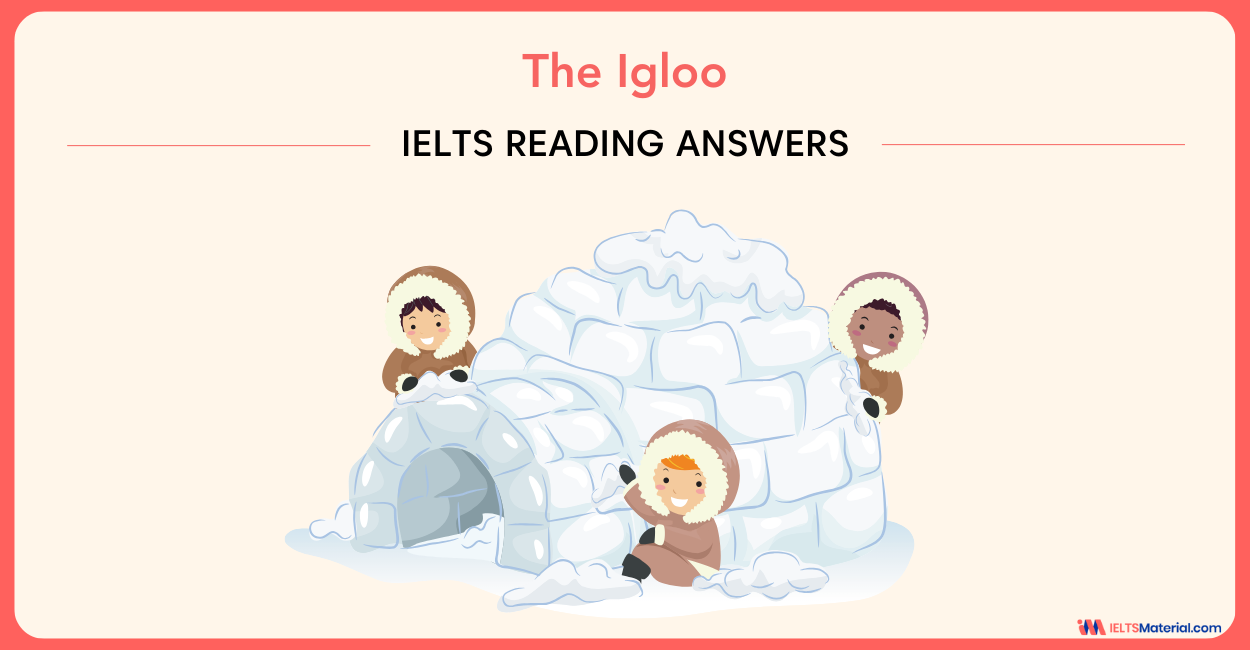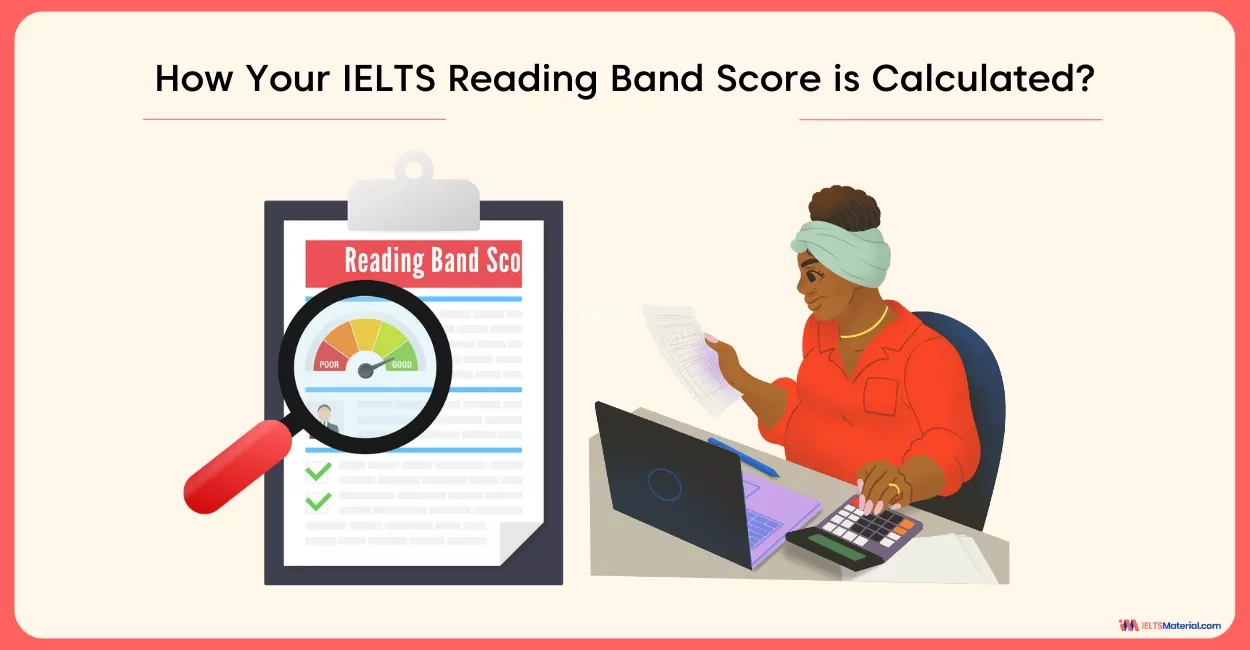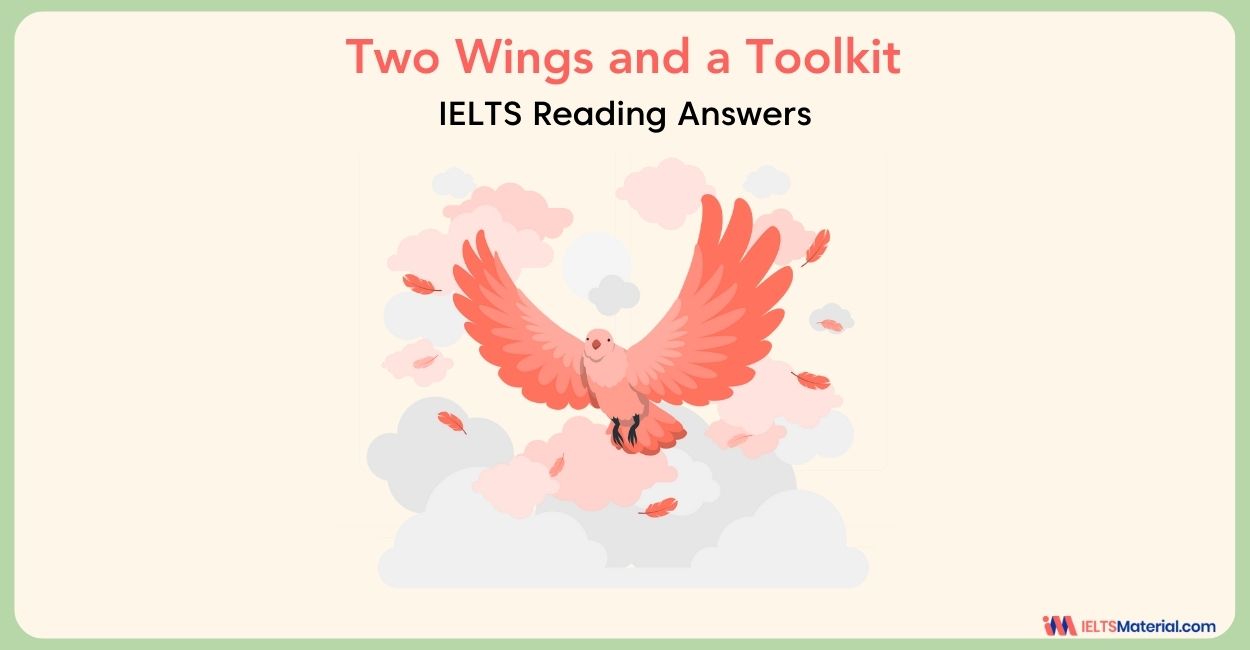Two Wings and a Toolkit IELTS Reading Answers
Want to ace IELTS Reading? Check out the Two Wings and a Toolkit IELTS Reading Answers with Explanation and expert step-by-step strategies to tackle questions precisely. Master key techniques, boost accuracy, and improve your score effortlessly!
Table of Contents

Limited-Time Offer : Access a FREE 10-Day IELTS Study Plan!
The passage, ‘Two Wings and a Toolkit’ is a reading passage that appeared in IELTS Academic Reading. Ideally, you should not spend more than 20 minutes on a passage. Since questions get repeated in the IELTS exam, these passages are ideal for practice. If you want more practice, try taking an IELTS reading practice test. There are 13 questions along with the passage, Two Wings and a Toolkit. The question types found are:
- Diagram Completion IELTS Reading (Q. 1-4)
- True/False/Not Given IELTS Reading (Q. 5-10)
- IELTS Reading Multiple Choice Question (Q. 11-13)
Two Wings and a Toolkit IELTS Reading Passage
Read the passage and instructions with utmost attention and answer the questions. Verify your answers with the two wings and a toolkit IELTS reading answers followed by the questions. You should spend about 20 minutes on Questions 1-13, which are based on the Reading Passage below.
Two Wings And A Toolkit
Alex Kacelnik, an animal behaviour expert in Oxford University has captive crows namely Betty and Abel. Both belong to the Corvus moneduloides (forest-dwelling species of bird) which are inhabiting two islands in the South Pacific. New Caledonian crows predate in a tenacious manner and these birds widely detect the self-made tools to find food.
Crochet hook is one of the brilliant tools of the wild crows. It is made by separating the side twig from a larger one and leaving the larger twig required to shape it into a hook. There is another cunning tool made from barbed vine-leaf, it contains a central rib associated with paired leaflets each with a thorn at its base. Wild crows remove all the leaflets and what remains is one thorn at the top. It results in a ready-made hook which will be helpful for picking out the insects from awkward cracks.
The crows also make an innovative tool named padanus probe made from padanus tree leaves. The tool has the following characteristics: broad base, sharp tip, a row of tiny hooks along one edge and the crow creates a tapered shape by nipping and tearing to construct a progression of three or four steps across the other edge of the leaf. This tool is regarded as special as it is manufactured based on a standard design which follows a set of instructions. Though it is not easy to catch a crow while it is clip out a padanus probe, we do have a lot of proof to prove their workmanship. The impressive thing is crows are consistently producing the same design at each and every time. This made the researchers to think whether the crows are capable of creating a vision and performing action according to that. Research reveals that genetics also influence the finches in the Galapagos islands which make less sophisticated tool making skills. But it is highly improbable whether this is same also for New Caledonian crows, like, its tool making skills are hardwired into its brain.
“Food in a bucket at the bottom of a well” challenge is offered to Betty and Abel as a test at Oxford by Kacelnik. The only method to get the food is by hooking the bucket out by its handle. Choice of tools is given: a straight length wire and one with a hooked end. The birds picked the hook immediately which shows that they can understand the functional properties of the tool.
It seems that they have the foresight and creativity to plan the construction of their tools. In one bucket in the well test, Abel took the hooks and what remains for Betty is nothing but the straight wire. Kacelnik exclaims, “What happened next was absolutely amazing”. She inserted the tip of the wire into a crack in a plastic dish and pulled the other end to create her own version of hook. Wild crows aren't able to get bendable material which retains its shape, and the similar experience encountered by Betty is with some pipe cleaners a year earlier. In ten further tests, she made a hook and took the bucket in nine tests.
To know what is actually happening in the crow's mind will take time and numerous experiments have to be done, but we could get a lesson based on our understanding of our own evolution. Our ancestors might not have the sophisticated mental abilities which helped them to create symmetrical tools with carefully worked edges about some 1.5 million years ago. Analysing the New Caledonian crows closely might have helped us to give clues about the special attributes they would have needed. Kacelnik says, ‘If we're lucky we may find specific developments in the brain that set these animals apart’.
This could be the result of a strong degree of laterality which means the specialisation of one side of the brain to perform particular tasks. For people, the left side of the brain is responsible for processing complex consequential tasks which include language and speech. Interestingly, Biologists have found that most padanus probes are cut from the left side of the leaf which means it used the right side of their beaks. The team thinks it reflects the fact that crow's left side of the brain is specialised to handle the sequential processing to make complex tools.
What conditions lay out a reason for emergence of the extraordinary talent for those two species ? Both are social creatures and have a wide range of feeding habits. These factors are likely to be important. But, it could be their limitation that triggered the evolution of toolmaking. Both the ancestors of crows and humans might be in the position where they aren't able to make the physical adjustments needed to survive. So, it becomes necessary to change their behaviour. This stage could set them to get cognitive skills which produce sophisticated tools. Those crucial skills could have been found from the New Caaledonian crows.
Confused about IELTS prep? Join our exclusive IELTS webinar and clear all your doubts!
Two Wings And A Toolkit IELTS Reading Questions
Questions 1 - 5
Do the following statements agree with the information given in the reading passage? Write
TRUE if the statement agrees with the information
FALSE if the statement contradicts the information
NOT GIVEN if there is no information on this in the passage
- Betty and Abel are sea-dwelling species of bird.
- One of the tools of crows is crochet hook which contains a central rib with paired leaflets.
- Wild crows aren’t able to live in tropical rainforests.
- In people, the left side of the brain is responsible for processing complex consequential tasks.
- Crow's shortcomings could have set an evolution for toolmaking.
Questions 6 - 9
Complete the sentences below.
Write NO MORE THAN THREE WORDS from the passage for each answer.
6. Betty and Abel are forest-dwelling species confined to two islands in _______.
7. Cunning tool which is made from ______ which contains central ribs with paired leaflets with a thorn at its base.
8. Choice of tools given in the bucket in the well test are ______ and one with a _______.
9. The ancestors of humans and crows might not be able to make _____ required for survival.
Questions 10 - 13
Complete each sentence with the correct ending, A–F, below.
Write the correct letter, A-F, as your answer to each questions (10-13)
10. Crochet hook is made by separating the side twig from a larger one and…
11. The crows’ innovative tool named padanus probe is..
12. Research reveals that genetics plays a role in the finches in the Galapagos islands which..
13. Biologists have found that most padanus probes are cut from…
A. inserting it into the crack of the plastic dish
B. the left side of the leaf which means it used the right side of their beaks.
C. leaving the larger twig required to shape it into a hook.
D. made from padanus tree leaves.
E. right side of the brain is active
F. make less sophisticated tool making skills.
Two Wings and a Toolkit IELTS Reading Answers with Location and Explanations
Now it’s time to check the answers to the above questions from the passage in the reading section of IELTS Academic, Two Wings and a Toolkit, and get an idea of how well you have mastered this section.
1. Question Number: 1
Answer: Crochet hook
Answer Location: Para 2, first 2 lines
Answer Explanation: The passage mentions the wild crows’ cleverest tools, with a crochet hook being used to detach a side twig from a larger one, leaving enough of the larger twig to shape into the hook.
2. Question Number: 2
Answer: Leaflets/leaves
Answer Location: Para 2, lines 2-3
Answer Explanation: The tool crafted by crows is a barbed vine-leaf, which consists of a central rib and paired leaflets, resembling a rose-like thorn at the base.
3. Question Number: 3
Answer: Thorn
Answer Location: Para 2, last 2 lines
Answer Explanation: Crows strip out a piece of the leaf rib, removing all but one thorn, which is then shaped into a ready-made hook to prise out insects from awkward cracks.
4. Question Number: 4
Answer: (Tapered) steps
Answer Location: Para 3, first 3 lines
Answer Explanation: Crows also make an ingenious tool known as the padanus probe from padanus tree leaves, which have a tapered shape. The crow nips and tears at the leaves in progression, producing three or four tapered steps.
5. Question Number: 5
Answer: TRUE
Answer Location: Para 3, lines 4-5
Answer Explanation: The passage explains that what makes this tool special is the manner in which crows manufacture it with a standard design.
6. Question Number: 6
Answer: TRUE
Answer Location: Para 3, lines 5-6
Answer Explanation: The statement is true because although it is rare to catch a crow in the act of clipping out a padanus probe, there is ample proof of its skillful workmanship.
7. Question Number: 7
Answer: FALSE
Answer Location: Para 3, lines 7-9
Answer Explanation: The remarkable thing about crows is that they consistently produce the same design without any trial versions or in-between designs.
8. Question Number: 8
Answer: TRUE
Answer Location: Para 3, lines 9-10
Answer Explanation: This statement is true because the researchers were left wondering if the crows could envisage the tool before they started making it, showing they already knew the actions needed.
9. Question Number: 9
Answer: NOT GIVEN
Answer Location: N/A
Answer Explanation: The answer is not provided in the passage.
10. Question Number: 10
Answer: FALSE
Answer Location: Para 3, lines 12-13
Answer Explanation: The passage argues that it’s highly unlikely that toolmaking skills are hardwired into the crow’s brain.
11. Question Number: 11
Answer: C
Answer Location: Para 7, lines 4-6
Answer Explanation: Biologists noticed that padanus probes are cut from the left side of the leaf by crows. The birds clip them with their beaks from the right side, which is similar to right-handedness in humans.
12. Question Number: 12
Answer: D
Answer Location: Para 7, line 7
Answer Explanation: The passage states that the left side of the crow’s brain is specialized to handle sequential processing, explaining the behavior observed in the crows.
13. Question Number: 13
Answer: G
Answer Location: Para 8, lines 6-7
Answer Explanation: The passage mentions that the crows had to change their behavior instead of following their usual method.
Want to improve your IELTS Academic Reading score? Grab Our IELTS Reading Ebook Today!
Tips to Answer Two Wings and a Toolkit IELTS Reading Answers
Since you have calculated your score from the Two Wings and a Toolkit answer keys, let us look at some quick IELTS exam preparation tips for each question type to boost your IELTS preparation.
Diagram Completion
The way to solve the Diagram Completion IELTS Reading is similar to Table Completion. You will be asked to fill in the blanks in a small passage given in the form of a diagram with the relevant words or numbers. So, let us revise the strategies.
- Read the instructions carefully. It will help you determine the word limit (no more than two, one word, etc) and important terms like ‘using words from the text’ or ‘from the text’. You have to follow these strictly.
- Go through the incomplete diagram first. Also, think about keywords and how they could be represented by synonyms or paraphrasing.
- Locate where the information is by scanning quickly. If you can’t, move on.
- Study the reading text by using the skimming and scanning techniques. It will help to establish the answer quickly. When scanning for your answer, make sure you are thinking about paraphrasing and synonyms.
- The answers appear in the same order as the questions. Also, check your spelling and remember that your answer should be grammatically correct.
True/False/Not Given
The ‘True/False/Not Given IELTS Reading’ questions are based on facts. Several factual statements will be provided to you, and it is up to you to determine whether or not they are accurate by reading the text. To answer this type of question, you can use the following IELTS Reading tips and techniques to increase your reading speed:
- Read the question and identify the keywords – Before reading the material, have a look at your list of True, False, and Not Given questions.
- Scan the passage for synonyms or paraphrased words of the keywords – When you have highlighted the keywords, swiftly read the text to look for paraphrases or synonyms.
- Match the highlighted words in the questions with their synonyms in the text – Once you find both sets of keywords, cross-check them to find the answer.
- Identify the answer – If the facts match, the answer is TRUE, and in case it doesn’t match, it is FALSE. If you are unable to find the answer or unsure of it, mark it NOT GIVEN.
Multiple-Choice Questions
You will be given a reading passage followed by several questions based on the information in the paragraph in IELTS Reading Multiple Choice Question. Your task is to understand the question and compare it to the paragraph in order to select the best solution from the available possibilities.
- Before reading the passage, read the question and select the keywords. Look for the keyword possibilities using IELTS Reading keyword techniques if the question statement is short on information.
- Then, using the keywords, read the passage to find the relevant information.
- To select the correct option, carefully read the relevant words and match them with each option.
- You will find several options with keywords that do not correspond to the information.
- Try opting for the elimination method and find the best option by matching the meaning rather than just the keywords.
Want to boost your IELTS score? Enroll in our expert-led IELTS online classes today!
Check More IELTS Reading Answers
| The Columbian Exchange Reading Answers | Why Does Music Move Us Answers |
| Electric Dreams Reading Answers | Wild Foods Of Australia Answers |
| Reading The Screen Answers | Care In The Community Answers |
Mastering the IELTS Reading Module requires practice, strategy, and a clear understanding of different question types. Two Wings and a Toolkit IELTS Reading Answers provide valuable insights into tackling real exam questions effectively. By consistently solving past IELTS reading passages and practice tests, you can enhance your comprehension skills and boost your overall score. Keep practicing and refine your reading strategies for success!
Also check:
Practice IELTS Reading based on question types

Start Preparing for IELTS: Get Your 10-Day Study Plan Today!
Explore other Reading Topics

Kasturika Samanta

Kasturika Samanta

Kasturika Samanta

Kasturika Samanta
Recent Articles

Nehasri Ravishenbagam

Haniya Yashfeen

Haniya Yashfeen

Haniya Yashfeen




Post your Comments